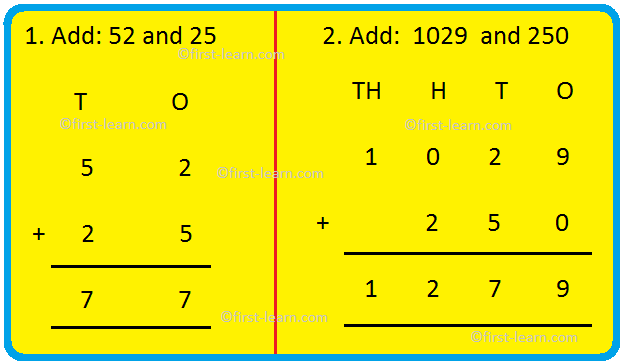Addition of Whole Numbers
Whole numbers are positive integers including zero. The main difference between whole numbers and natural numbers is that natural numbers are also positive integers but does not include zero. Hence we can say that natural numbers means whole numbers whereas, whole numbers does not mean natural numbers.
Example : { 0, 1, 2, 3, 4, 5, 6, 7, 8, 9, ………..}
There are main four types of operation done in whole numbers that is addition, subtraction, multiplication and division. Any negative integer, fraction or decimal is not considered as whole numbers. Whole numbers are often called as counting numbers however, counting numbers does not include zero as zero cannot be counted. So counting numbers along with zero is termed as whole numbers.
The first or the most basic operation of whole numbers is ADDITION.
The steps for addition of whole numbers are as follows:
I. Firstly the numbers are written under ones, tens, hundreds, thousands, ten thousands and so on
II. Then starting from the ones column they are added. If there is any carry over in the ones column then that is adjusted in the tens column. Furthermore, if there is any carry over in the tens column then that is adjusted in the hundreds column and so on.
Examples of addition of 2 digit whole number without carry over:
1. Add: 52 and 25
T O
5 2
+ 2 5
7 7
Here in the ones column 2 + 5 = 7 and in tens column 5 + 2 =7. That gives the answer 77
2. Add: 73 and 16
T O
7 3
+ 1 6
8 9
Here in the ones column 3 + 6 = 9 and in tens column 7 + 1 =8. That gives the answer 89
Examples of addition of 3 digit whole number with carry over:
3. Add: 103 and 89
H T O
1 0 3
+ 8 9
1 9 2
Here in the ones column 3 + 9 = 12. But we cannot write 12 hence 2 is written in the ones column and 1 is carried over in the tens column. Therefore the subtotal of tens column will be 0 + 8 + 1 (carryover) = 9. In hundreds column only 1.
Examples of addition of 4 digit whole number without carry over:
5. Add: 1029 and 250
TH H T O
1 0 2 9
+ 2 5 0
1 2 7 9
Here in the ones column 9 + 0= 9. In the tens column 2 + 5= 7 and In hundreds place 0 + 2 = 2 , in thousands place only 1.
Examples of addition of 4 digit whole number with carry over:
7. Add: 3569 and 2510
TH H T O
3 5 6 9
+ 2 5 1 0
6 0 7 9
Here in ones place 9 + 0 is 9 and in tens place 6 + 1 =7 with no carry over in these two places. However, in the hundreds place 5 + 5= 10 there will be a carryover. We cannot write 10 so we will write only 0 and 1 would be carried over in thousands place. Therefore the subtotal of thousands place will be 3 + 2 + 1 (carryover) = 6
8. Add: 4315 and 1659
TH H T O
4 3 1 5
+ 1 6 5 9
5 9 7 4
Here in the ones place 5 + 9 = 14 so 1 will be carryover in tens place and we will write only 4 in ones place. The subtotal of tens place will be 1 + 5 + 1 (carryover) = 7 with no carryover. In the hundreds place 3 + 6 =9 with no carryover and again in the thousands place 4 + 1 = 5 with no carryover as well.
From Addition of Whole Numbers to HOME PAGE
Recent Articles
-
What Is Plasma? | Blood Plasma | Proteins | Nutrients | Cholesterol
Nov 07, 25 10:29 AM
Blood is a mobile fluid which is a connective tissue and is derived from the mesoderm like cell any other connective tissue. Colour of blood is reddish and that flows inside the blood vessels by means… -
Disorders of Respiratory System | Tuberculosis | Pleurisy | Emphysema
Oct 28, 25 11:39 PM
Tuberculosis is very common disease and is caused by a type of bacteria called Mycobacterium tuberculosis. This disease causes different trouble in the respiration and infection of several parts of th… -
Regulation of Respiration | Respiratory Centres | Inspiratory Area |
Oct 14, 25 12:13 AM
Respiratory Centre is the area that controls the rate of respiration and it is observed to be located in medulla oblongata and pons. Respiratory Centre has the following will dispersed components like… -
Explain Transport of Gases | External Respiration | Tissue Respiration
Oct 09, 25 11:35 PM
In humans gaseous exchange is completed in the following ways the steps are - External Respiration or Breathing - Breathing in false taking in of Oxygen and giving out of carbon dioxide in the body. M… -
Kind and Number of Teeth | Location of Teeth in Mouth | Care of Teeth
Sep 11, 25 12:52 AM
Kind and Number of Teeth






New! Comments
Have your say about what you just read! Leave me a comment in the box below.